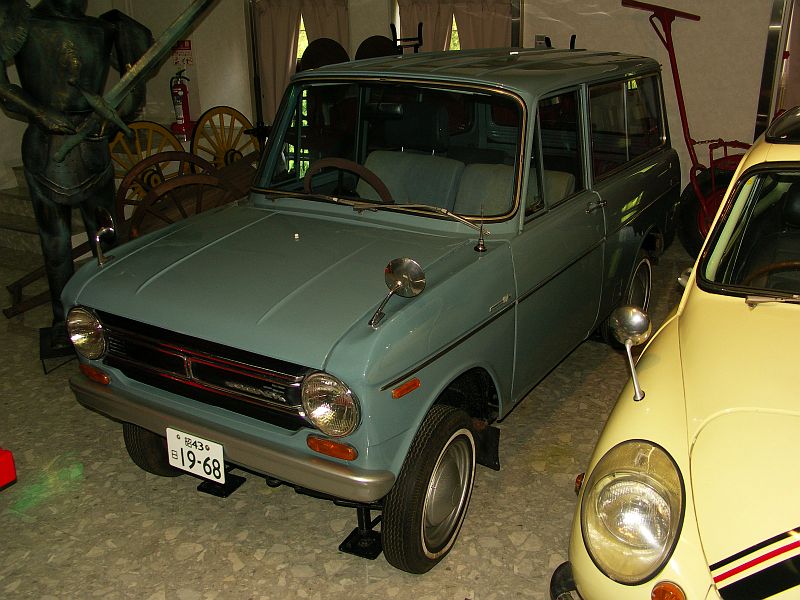The late 1960s marked a transformative period in Japanese automotive history. Urban spaces were becoming increasingly crowded, and the need for efficient, compact transportation solutions was reaching its peak. The streets of Tokyo and other major cities were witnessing a revolution in personal mobility, as manufacturers competed to create the perfect balance between utility and minimal footprint.
Enter the Aichi Cony 360 AF7V, a vehicle that embodied the ingenuity of Japanese engineering in the microcar segment. Launched in 1968, this compact marvel represented a unique approach to the challenges of urban transportation, combining practical design with innovative engineering solutions.
Engineering Marvel in Miniature
The heart of the Aichi Cony 360 AF7V beats with remarkable efficiency. Its two-stroke, twin-cylinder boxer engine, designated as AE58B, produces a respectable 20.6 horsepower from just 354 cubic centimeters. The engine’s design reflects a masterful understanding of space utilization, with its horizontally-opposed cylinder configuration contributing to a lower center of gravity.
Fact!
The Aichi Cony's engine achieved an impressive fuel efficiency of 88.1 miles per imperial gallon — a figure that would be considered competitive even by today's standards.
«The boxer engine configuration was a stroke of genius for a vehicle of this size,» notes Takashi Yamamoto, vintage Japanese car restoration specialist. «It provided excellent balance and allowed for a more spacious cargo area — features that were revolutionary for microcars of that era.»
The engineering excellence extends beyond the engine bay. With a compression ratio of 7.5:1 and air cooling system, the powerplant demonstrates remarkable reliability while maintaining simplicity in design and maintenance.
Design and Practicality
The Cony 360’s three-door configuration maximizes accessibility while maintaining structural integrity. At just 1470mm in height and with a curb weight of 575kg, the vehicle exemplifies efficient space utilization without compromising on functionality.
The station wagon body style represents a practical approach to urban utility. The interior layout accommodates four passengers, while the flexible cargo space adapts to various loading requirements — a feature that set it apart from many contemporaries.
Historical Reference!
The Aichi Cony 360 AF7V was part of Japan's kei car revolution, which began in 1949. These vehicles were designed to meet specific tax and insurance regulations, making car ownership accessible to a broader segment of the population.
«I’ve owned my Cony for over three decades,» shares Kenji Suzuki, classic car collector. «Its practical design continues to impress me. The cargo space is remarkably versatile, and the access through the rear door is exceptionally well thought out.»
Performance and Economy
In terms of performance, the Cony 360 achieves a top speed of 75 km/h, perfectly suited for urban environments of the late 1960s. The three-speed manual transmission, coupled with rear-wheel drive, provides:
- responsive acceleration in city traffic;
- stable cruising characteristics;
- efficient power delivery at various speeds;
- reliable performance in diverse conditions;
- economical operation for daily use.
The vehicle’s modest dimensions contribute to impressive maneuverability, while the mechanical simplicity ensures straightforward maintenance and reliability.
Legacy and Collector’s Perspective
The Aichi Cony 360 AF7V’s production run from 1968 to 1970 may have been brief, but its influence on Japanese automotive design persists. The vehicle represents a crucial chapter in the evolution of practical urban transportation.
Important!
The Aichi Cony 360 AF7V remains one of the most authentic representatives of Japan's post-war industrial renaissance, with fewer than 100 examples estimated to survive today.
«These vehicles tell an important story about Japanese innovation,» explains Dr. Hiroshi Tanaka, automotive historian. «The Cony 360 exemplifies how manufacturers addressed specific market needs with ingenious engineering solutions.»
Today, surviving examples are highly sought after by collectors, particularly those interested in the unique chapter of automotive history represented by Japanese microcars.
A Pioneer’s Legacy
The Aichi Cony 360 AF7V stands as a testament to an era when innovation was driven by practical necessity. Its influence extends beyond its brief production run, having contributed to the evolution of compact vehicle design and urban mobility solutions.
The vehicle’s legacy lives on in modern Japanese kei cars, which continue to embrace the principles of efficient design and practical utility that the Cony 360 helped establish.
| Pros | Cons |
|---|---|
| Innovative boxer engine design providing excellent balance | Limited top speed of 75 km/h |
| Exceptional fuel economy for its era | Three-speed transmission may feel limited by modern standards |
| Practical three-door layout with versatile cargo space | Sparse availability of replacement parts |
| Lightweight construction enhancing maneuverability | Two-stroke engine requires specific maintenance knowledge |
| Historical significance in Japanese automotive development | Limited passenger capacity compared to modern vehicles |
| Simple mechanical design facilitating maintenance | Air-cooling system may struggle in extreme conditions |
| Compact dimensions ideal for urban environments | Rare status makes finding examples challenging |
The Aichi Cony 360 AF7V represents a fascinating intersection of necessity, innovation, and practical engineering. While its limitations reflect the technological constraints of its era, its strengths — particularly in terms of efficiency and practicality — remain relevant today. For collectors and enthusiasts, it offers a unique window into a transformative period in automotive history, combining historical significance with innovative engineering solutions that continue to inspire.

